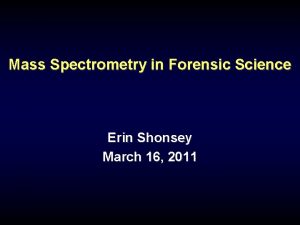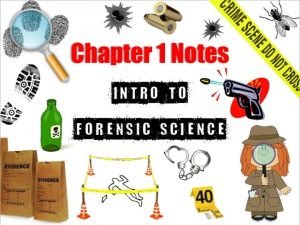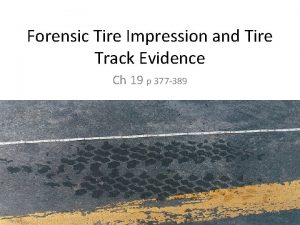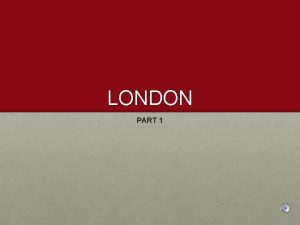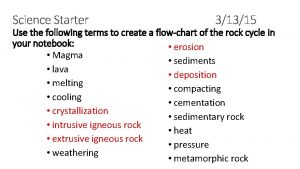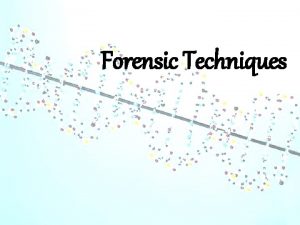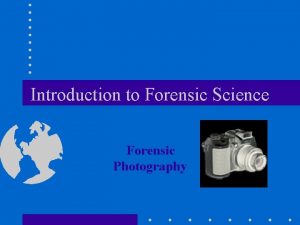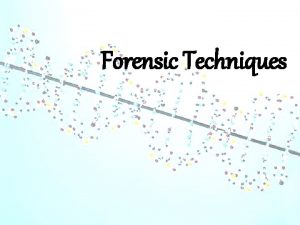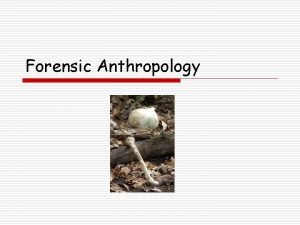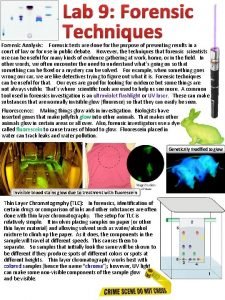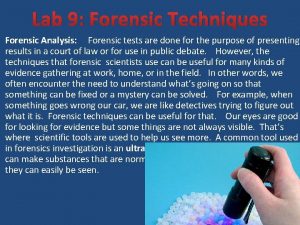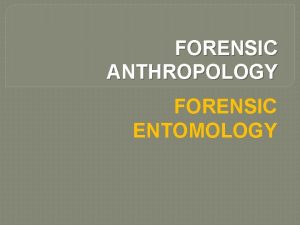The London Letter Day 2 Forensic Science 31315















- Slides: 15

The London Letter, Day 2 Forensic Science 3/13/15

Drill Take out The London Letter. Sign it at the bottom of the first page. What do you notice about the text of The London Letter? HW: Use the textbook to answer Review Qs #14 -19

Objectives IWBAT Use the 12 traits of handwriting to analyze two documents. Discuss document examination Experience how to collect document samples

The London Letter – Part 2 Listen to Ms. Bloedorn’s dictation and directions. When done, pass the packets to the front.

Analysis Now you have another person’s copy of The London Letter. Your mission is to PROVE that the same person wrote both—you know it, so prove it!

Analysis On the third page: Make a list of all the similarities that you can find between page 1 and 2 Write a conclusion summarizing the similarities and why you think these came from the same person.

Faking a Signature There are three ways a person’s signature can be forged: traced forgery simulated forgery blind forgery.

Fake Signature by Traced Forgery Procedure: Work in table groups One student writes his/her signature four times with heavy pressure on a piece of blank paper (A), with a pencil. Place another piece of paper (B) under this piece, each time while writing. Everyone else will observe paper B. Try to forge the signature by tracing the mark left on paper B. Let’s discuss Traced Forgery.

Comments on Traced Forgery Tracing is the most amateurish method of imitating a signature. Tracing method: trace-over method The faint outline of a genuine signature is transferred onto a sheet of paper placed underneath it by means of heavy pressure or the use of transfer paper.

This outline, either an indented or a graphite- or carbon-paper copy, is then traced over in ink with an appropriate ball pen or pen. Drawback of Traced Forgery. May leave forgery evidence because it is difficult to follow the outline exactly and hence traces of the indentations or the carbon or graphite outline may appear in the forged signature or text.

Simulated Forgery Work in same groups. One student writes down his/her signature on a piece of paper. Other group members try to imitate the signature freehand. Select the most alike fake signature and compare it with the genuine signature under a magnifying glass. Compare traced forgery and simulated forgery.

Simulated Forgery is to produce forgeries freehand. Simulated Forgery includes the slowly copied forgery (poor qualities) & the practiced freehand forgery (more successful)

Comparison of Traced Forgery and Simulated Forgery is far superior to Traced Forgery because a talented artist or calligrapher may learn to sign a name remarkably similar to the targeted signature if he/she can have sufficient time to practice the signature freehand.

• However, Simulated Forgery can be detected by carefully observing the basic characteristics of handwriting such as the overall form (the size, shape, slant, proportion, the beginning & ending strokes of the letters); • line features (writing speed, pen pressure, spacing between letters and words and how the letters are connected); • margins and format (width of margins, spacing); and • content (punctuations). •

Closure Was it difficult to disguise your handwriting? Why or why not? What aspect of the disguised writing was easiest to recognize as the same?
 Day 1 day 2 day 3 day 4
Day 1 day 2 day 3 day 4 Day 1 day 2 day 817
Day 1 day 2 day 817 Forensic anthropologist vs forensic pathologist
Forensic anthropologist vs forensic pathologist Who is this
Who is this Sky letters grass letters root letters
Sky letters grass letters root letters Geography is my favourite at school
Geography is my favourite at school What is hegar's sign
What is hegar's sign Hair analysis definition
Hair analysis definition Mass spectrometry in forensic science
Mass spectrometry in forensic science Chain of custody forensics
Chain of custody forensics How many people did aileen wuornos kill
How many people did aileen wuornos kill Important people in forensics
Important people in forensics Tire impressions
Tire impressions Forensic science serology
Forensic science serology Locard's exchange principle
Locard's exchange principle Forensic science foodborne outbreak investigation answers
Forensic science foodborne outbreak investigation answers








